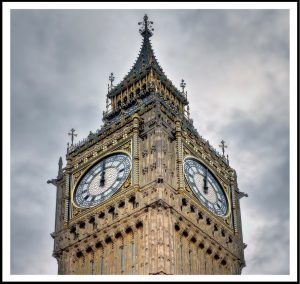by Bill Murray
 47-year old Teburoro Tito stood at the head of his delegation on an island way out in the Pacific Ocean. At the stroke of midnight on January 1st, 2000 the President of Kiribati handed a torch to a young man, ceremonially passing the future to a new generation.
47-year old Teburoro Tito stood at the head of his delegation on an island way out in the Pacific Ocean. At the stroke of midnight on January 1st, 2000 the President of Kiribati handed a torch to a young man, ceremonially passing the future to a new generation.
Nobody lived there. Nobody ever went out there. When the designers of the International Date Line put marker to map, they drew right through the 33 islands that wouldn’t become Kiribati for 95 more years. They were just trifling bits of land, of no concern to cartographers 9050 miles away in London.
But there the little group stood because in 1994 the I-Kiribati president “applied to have a slight loop inserted into the date line that included all its islands in one time zone…. The Greenwich Observatory sanctioned his proposal and thus it was that his little nation profited greatly from the millennial hoopla.”
Dancers in grass skirts played to the cameras and the Kiribati archipelago made its claim to be the first to welcome the new millennium. The US Navy submarine Topeka made its own claim, positioning itself 400 meters underwater straddling both the date line and the equator.
New Zealand claimed the new millennium’s first sunrise. Their Chatham Islands, 500 miles east of the rest of New Zealand, got about a forty-minute jump on the rest of the country.
The real first dawn over land was near remote Dibble Glacier in Antarctica, but it was midsummer there, and you couldn’t really call it dawn, because the sun had never even set. If anybody was there, they never mentioned it.
 All these ‘firsts’ staked subjective claims on the new millennium. They couldn’t have all been first. But then, people have been making questionable claims on time since, well, day one. In the course of compiling Easter tables for the Pope, a sixth-century Scythian scholar named Dionysius Exiguus (Dennis the Little) suggested that, you know, the Christian era really should date from the birth of Jesus, which should be designated as the year 1.
All these ‘firsts’ staked subjective claims on the new millennium. They couldn’t have all been first. But then, people have been making questionable claims on time since, well, day one. In the course of compiling Easter tables for the Pope, a sixth-century Scythian scholar named Dionysius Exiguus (Dennis the Little) suggested that, you know, the Christian era really should date from the birth of Jesus, which should be designated as the year 1.
Problem: Dionysius operated in Roman numerals. The concept of zero had yet to enter Western mathematical thinking, so the Christian calendar skipped right by the twelve months of year zero needed to get to year one. Twelve months off, right from the start.
•••••
Friday, June 10th, 2016: The first day of the UEFA Euro 2016 championship. The host team opened the tournament in the Stade de France, Paris. France was seized with security concerns that summer but terror was the last thing on people’s minds in a tiny French outpost where we joined the high-spirited crowd at the Bar Le Rustique for “bucket beer,” a scheme in which five tiny Heinekens were served in an ice bucket for the price of four.
They screamed and stomped and chewed their nails until – finally – in the 89th minute the home team found the net for a 2-1 victory over pesky, persistent Romania. Most incongruent, poignant even, this full-throated table-pounding nationalism, for we were 2650 miles from the Stade de France in a forgotten overseas corner of France, a collection of tiny islands just south of Newfoundland called St. Pierre et Miquelon.
Canada follows an orderly hour-by-hour progression of time zones except in the east, where Newfoundland, a separate colony and not part of Canada when time zones began, set its time zone a half hour ahead of Atlantic time, itself an hour later than U.S. Eastern time. And even though you can walk up the hill from Bar Le Rustique and look over to Point May on the Newfoundland coast, St. Pierre adds an additional half hour still. It helps the Saint-Pierrais feel closer to La France.
The match started at 21:00 in France, 17:00 in St. Pierre. Just four hours to cross the whole the Atlantic.
•••••
Samoa Sacrifices a Day for Its Future
29 Dec 2011
The Pacific island nation of Samoa and its even tinier neighbor Tokelau are skipping Friday this week, jumping westward in time across the international date line and into the shifting economic balance of the 21st century….
In this giant-step version of daylight saving time, the island’s 186,000 citizens, and the 1,500 who live in Tokelau, will go to sleep on Thursday and wake up on Saturday. The government has decreed that those who miss a day of work on Friday will be paid all the same.
•••••
 Imagine having the power to set the very time of day! Governments fancy fiddling with time, and it’s not just the king of Samoa:
Imagine having the power to set the very time of day! Governments fancy fiddling with time, and it’s not just the king of Samoa:
• When Japan invaded Malaya in 1942, Malaya moved to Tokyo time – and then moved back once Japan was defeated. Berlin time followed Hitler’s armies’ west across the continent, so that today Madrid, 200 miles west of London, still runs on Berlin time.
• China once had five time zones but since 1949 the whole country runs on Beijing time. That doesn’t mean everyone observes it. The non-Han population in Xinjiang, in particular, “… live life according to the sun,” says a blogger: “They work from ten to seven instead of eight to five, and school starts at nine or ten am.”
• Trans-Siberian trains officially run on Moscow time, even when Vladivostok was eleven time zones away (It is now nine, as Vladimir Putin consolidated two time zones by decree in 2010). When Russia annexed Crimea in 2014, the peninsula’s clocks advanced two hours to Moscow time.
• Kim Jong-un moved North Korea time back a half hour in 2015, reverting to the time it observed before the Korean peninsula’s conquest by Japan. Last May, though, he changed it back to peninsula time, perhaps in the spirit of normalizing North/South Korean relations.
• In 2007, Hugo Chávez set Venezuela’s clocks back by thirty minutes to create “a more fair distribution of the sunrise.” In 2016, with Chávez safely dead for three years, Nicolás Maduro moved them forward again.
•••••
Until about two and a half centuries ago, nobody felt much need to measure time more precisely than simply “midday,” when the sun is highest in the sky. Before the Industrial Revolution, and factory shift work, the world looked at time from a looser perspective.
A thousand years ago the birthplace of industrialization stretched open and wild, movement unimpeded for any who came. People settled at crossroads, in valleys or along streams. They proclaimed their farmstead anywhere they might summon from the earth a way of life.
Settlements grew into villages that had no name. They didn’t need a name because to the villagers, everybody in the world lived there. It was just … the village. Time divided no more precisely than by the daily movement of the sun, and the seasons for working the earth.
A millennium before President Tito’s millennial torch passing, northern Europeans had only one name. Villages with no name at all were made up of Hakon and Garth and Canute and Canute’s son or Magnus’s daughter.
Only once a concentration of people required differentiation might a town adopt the surname of the local lord, or individuals take on a second name indicating vocation or eccentricity, like Magnus (the) Cooper, Johann Longnose or the king who consolidated Norway, Harald Fairhair. Or in Rome, Dennis the Little.
Villages that grew into towns protected themselves behind walls. By day the fields outside the walls needed tending, and each afternoon as darkness advanced, towns rounded up field workers with bells, drums or horns. Guards raised drawbridges over moats. Sentinels patrolled the ramparts. In Italian towns, guards were obliged to ring a bell every five minutes to signal that none had fallen asleep.
(Apparently Jean Jacques Rousseau was a perennial laggard. At least three times barred by Geneva’s gates, he wrote, “About half a league from the city, I hear the retreat sounding; I hurry up; I hear the drum being beaten, so I run at full speed: I get there all out of breath, and perspiring; my heart is beating; from far away I see the soldiers from their lookouts; I run, I scream with a choked voice. It was too late.”)
Some places, you could buy your way in after hours. Der Einlasse (the wicket-gate) in Augsburg allowed passage through a series of locked chambers and across a drawbridge – for a fee.
Authorities seemed to favor noise-making in those days. Bells warned families to get to bed once cooking fires were covered. The word “Curfew” descends from the French “covre-feu,” or “cover-fire.”
 When mechanical clocks began to appear on town squares, proud city fathers added midday bells or chimes. Since early clocks were none too accurate, it’s easy to imagine the cacophony, like at sunset in the Middle East when battling muezzins call to their flocks at slightly different times from every street corner.
When mechanical clocks began to appear on town squares, proud city fathers added midday bells or chimes. Since early clocks were none too accurate, it’s easy to imagine the cacophony, like at sunset in the Middle East when battling muezzins call to their flocks at slightly different times from every street corner.
•••••
The coming of trains necessitated coordination of time across space, a problem manifest by the 1830s in England where, for example, local noon in Bristol was already ten past twelve in London, a hundred miles to the east. Still, for England-sized countries, adjustment to a single time zone was relatively straightforward. There, the sun-time difference between the most easterly and westerly points is only about 30 minutes.
The challenge came for sprawling lands. Russia’s standard Trans-Siberian railroad timetables, set to Moscow time, originated in 1880, when Tsar Alexander II set the trains to St. Petersburg time (which is the same as Moscow time).
On our own Trans-Siberian trip, we planned to leave the train for a few days at Irkutsk, and as we drew close (close in Siberia is approximately less than a day), one morning before her daily vacuuming tour I visited the provodnitsa’s den down by the samovar with the drying mushrooms on top, to make sure of our arrival time. I had written “Irkutsk” in Cyrillic on a card and I said “пожалуйста,” or please. She smiled and put down her gossip magazine. I pointed at the word, my watch, turned up my palms and shrugged.
She asked, speaking fast Russian and gesturing, “Moscow time or local time?” and since I knew how to say the word Москва, I chose Moscow time and she clucked “nyet nyet nyet” and wrote it for me in local time (2:25 a.m.) and then in Moscow time (9:25 p.m.).
•••••
Sir Sandford Fleming, a Scottish emigrant to Canada, helped to lay the Canadian Pacific railway as a young man. It’s said that he saw the need for standardized railroad time when he missed a train before times were coordinated station to station. Fleming worked to convene the 1884 International Meridian conference, which adopted a new worldwide standardized time scheme.
In theory, it ought to have been a straightforward affair. The earth rotates about fifteen degrees per hour, 24 times 15 equals the nice, neat 360 degrees in a circle, and there are 24 hours in a day.
But wait. A United States delegate, an amateur astronomer named Lewis Morris Rutherford (there is a crater on the moon named after him) stood to remark that, “it has been represented to me that it may, perhaps, be found advantageous in different countries and different localities to use a time that would not be accurately described as local time.”
He meant that governments wanted the right to fiddle with time. From there it was only a matter of time until discrepancies arose at borders, where sovereignties collide:
• Most places, the time zone to your east is an hour later. But if you travel east from Vladivostok to Japan, you set your watches back two hours.
• All 3250 east-west miles of China run on Beijing time. Because Afghanistan borders China to the west, farthest from Beijing where China time has gotten all out of whack, and because Afghanistan runs an idiosyncratic half hour off the normal GMT gradations, a man and his yaks moving between China and that odd, narrow arm of Afghanistan known as the Wakhan Corridor will encounter a 3-1/2 hour time change. (Here’s a must-have app for every Afghan herder: China to Afghanistan time converter.)
• Like Afghanistan, Burma, Iran and India run a half hour off the (relatively) orderly rest of the world. India’s single standardized time zone isn’t as mad as it was before independence. During the Raj, the colony operated three main times: Bombay Time, GMT+4:51, Madras Time, GMT+5:21, and Calcutta Time, GMT+5:54.
• The far eastern Russian island of Big Diomede runs on GMT+12 while Diomede, Alaska uses GMT-9. When not obscured by fog these islands are line of sight 2.4 miles apart in distance and three hours in time.
• A tiny, uninhabited Baltic skerry called Märket, home to an automated lighthouse and a community of gray seals is co-owned by Sweden and Finland and uses both of their time zones, about 4.1 acres for each. On the other side of Finland, if you wade across the Russian river Paz (Paatsjoki in Finnish) and walk two miles northwest from the little town of Раякоски, you can straddle three countries where if it is noon in Russia, it’s 11:00 a.m. In Finland and 10:00 a.m. In Norway.
•••••
Time and space work differently not just east to west, but also north to south. Longitudinal lines converge toward a single point at each of the poles, so that the width of time zones varies.
Suppose that next Tuesday you wake up on the equator. Swinging in your hammock on the beach and turning with the earth, you will travel the earth’s full circumference, 24,901 miles that day (not counting the swinging).
Pull your calculator from your bathing suit, divide 24,901 by the length of a day, 23 hours, 56 minutes and four seconds, and you find that you have been traveling 1,040 miles per hour.
At Longyearbyen, in the far northern Svalbard archipelago, more than the beachwear is different. the circumference of the earth at that latitude is just 5,101 miles. At 78 degrees north the earth turns at a leisurely 215 miles per hour. The Central European time zone at Svalbard stretches just 212 miles. With the fastest car and a good road you could just about drive across the time zone before an hour was up, and go back in time.
•••••
 Trains prompted the need for time zones, Balkanizing the world into 24 (and then more) different, complicated times for travelers. Fast trains can almost do that Svalbard trick of taking you back in time. Through time magic, the Eurostar train #9117 arrives in London four minutes before it leaves Calais.
Trains prompted the need for time zones, Balkanizing the world into 24 (and then more) different, complicated times for travelers. Fast trains can almost do that Svalbard trick of taking you back in time. Through time magic, the Eurostar train #9117 arrives in London four minutes before it leaves Calais.
But there are also willfully slow trains, the kind Olga Tokarczuk writes about in Flights, like the sleeper from Szczecin to Wroclaw, which runs 10:30 to 7:00 even though it really only needs five hours. These are the best trains, the ones that challenge the passenger with more time than she needs. The ones that slow her down. That place an avuncular palm on her shoulder and ask, what’s the hurry?
In a great rush to modernize, Morocco has borrowed a billion and a half dollars to finance a French TGV bullet train from Casablanca to Tangier. The Guardian quotes Ahmed Hakim, a 32-year-old Marrakech resident:
“Why would I need to get from Casablanca to Tangier in less than four hours?” he asks. “Moroccans spend four hours sitting in a cafe. If we want to travel, we have time.”
That’s the spirit.
